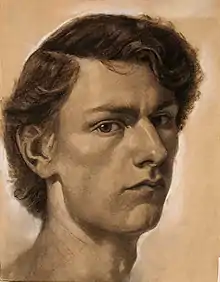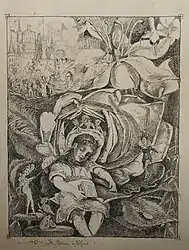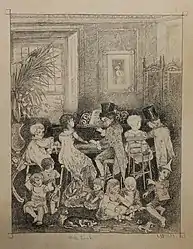Charles Joseph Fiscus | |
|---|---|
 Self-portrait | |
| Born | May 26, 1861 |
| Died | February 6, 1884 (aged 22) Indianapolis, Indiana |
| Resting place | Crown Hill Cemetery |
| Education | Indiana School of Art |
| Occupation | Artist |
Charles Joseph (C.J.) Fiscus was a pioneer Indiana artist (1861–1884) who specialized in landscapes, portraits, and still life, and played an important role in early Indiana art.
Biography
Indiana pioneer artist Charles Joseph (C.J.) Fiscus was born in Indianapolis, Indiana, on May 26, 1861. It was a tumultuous time in American history. The American Civil War had just started on April 12, 1861, and, like the rest of the nation, Indiana was swept up in war fervor. C. J. Fiscus was the son of Thomas W. Fiscus (1832-1889), a brick mason, and Elizabeth Jennie Fiscus (1834-1920), a homemaker and dressmaker.[1] While the Civil War devastated some Indiana families due to political differences, deaths, and/or long separations, it appears this was not the case for the young Fiscus family. For the first two years of the Civil War Thomas Fiscus continued working uninterrupted at his trade and only experienced two relatively short interruptions for military service during the last two years of the war when he responded to Governor Oliver Perry Morton’s (1823-1877) calls for additional soldiers.[2] By the time the Civil War had ended on April 9, 1865, the Fiscus family was residing at 280 East St. Clair Street in the home where C.J., or Chas as he was sometimes referred to, would spend not only his formative years but much of the remainder of his life.[3]
Indiana School of Art (1877–1879)
Following the Civil War, Indianapolis continued to expand under the governorships of Conrad Baker (1817-1885) and Thomas Andrews Hendricks (1819-1885). Native Hoosiers James Farrington Gookins (1840-1904) and John Washington Love (1850-1880) were both accomplished artists who had trained professional both domestically and in Europe. By 1877, the two men were in Indianapolis and shared a vision of making the growing city a western art hub. To help realize their vision, Gookins and Love rented the third floor of what was then known as the Fletcher & Sharpe Block, on the southwest corner of Washington and Pennsylvania Streets. On October 15, 1877, Gookins and Love opened the doors to the Indiana School of Art (ISA).[4] For $10 per month students were promised, “Neither pains nor expense spared to give pupils the most thorough and practical knowledge of principals and methods of art work”.[5] C. J. Fiscus became one of the early students at the ISA where he could take courses in drawing: freehand, perspective, and artistic anatomy from Love and courses in painting: figure, landscape, and decorative painting in oil and watercolor from Gookins in the eleven rooms of the school.[6] Fiscus learned artistic techniques alongside other talented students such as William Forsyth (1854–1935), who would later gain fame as one-fifth of the Hoosier Group of artists. Fiscus thrived at the institution, "Charles Fiscus was among the most talented pupils of this early school. He was marked "first" by the master more often than not and is still remembered by his fellow-students as having unusual ability".[7]

Indiana Art Association
Being a student at the ISA allowed C.J. Fiscus to hone his skills as an artist and as an exhibitor. After holding two successful three-week public exhibits of faculty and student work, a bigger, bolder exhibit that included works by artists from around the world was planned for the ISA.[8] On May 7, 1878, the newly formed Indiana Art Association (IAA), under the direction of the ISA, opened its First Quarterly Exhibition at the school. Fiscus displayed eight crayon drawings at the show: #247: "Apollo Belvidere" (bust), #248: "Farnese Hercules", #249: "Apollo Belvidere" (Figure), #250: "An Arm", #251: "Study from Life", #252: "Study from Life", #253: "William" (A Life Study), #254: "A Composition", alongside the works of accomplished artists such as Jacob Cox (1810-1892), Otto Sommer (1811-1911), Alfred Thompson Bricher (1837-1908), William Forsyth, and another future one-fifth of the Hoosier Group, Theodore Clement (T.C.) Steele (1847-1926).[9]
The Bohemian Club
As late as 1879, many Hoosiers were still feeling the effects of the Panic of 1873, and the economic depression it triggered.[10] In short, money was tight and funding for the arts was not a top priority for the citizens of Indianapolis. As a result, the ISA quickly declined. In response, C.J. Fiscus and six other artists: William Forsyth, William Ebbert (dates unknown), Frederick A. Hetherington (1859-1931), Thomas E. Hibben (1859-1915), Charles Nicolai (1856-1942), and Frank Edwin Scott (1863-1929) formed the Bohemian (Bohé) Club and rented courtyard rooms at the Fletcher & Sharpe Block location. The club was a place for artists to socialize and continue honing their artistic skills. Forsyth later wrote of the club, “There were no officers of any kind. It lived up to its name in every way—[We] talked, sang, played cards and pranks, was fused with enthusiasm, and incidentally drew, painted, and etched, and was much given to long excursions into the country where most of its real work was done.”[11] Later that same year, much to the chagrin of the remaining students and faculty, the ISA was forced to permanently close its doors due to lack of funding and waning interest.[12]
The new decade brought new adventures, challenges, and hardships for C.J. Fiscus. On June 24, 1880, the revered John Love died at only twenty-seven-years-of-age due to inflammation of the stomach.[13] The Bohé band of brothers: Charles Fiscus, William Forsyth, Thomas Hibben, Charles Nicolai, Frederick Hetherington, and Frank Edwin Scott came together to serve as pallbearers for their former teacher, mentor, and friend.[14] Whether the result of, or just a coincidence, the demise of John Love seemed to signal an exodus of artists from Indianapolis. In the fall of 1880, T.C Steele, John Ottis Adams (1851-1927), and Samuel Richards (1853-1893) migrated to Germany for continental training. Around the same period, the entrepreneurially minded Gookins left Indianapolis to open a studio in Terre Haute, Indiana. Fiscus chose to follow his teacher and mentor to Terre Haute to continue his artistic studies and to make an excursion to Chicago.[15] However, Fiscus returned to Indianapolis in a short time to start down his own artistic path.
Fiscus and Scott
Back home again in Indianapolis and inspired by the art and entrepreneurship of Gookins, C.J. Fiscus was confident enough in his artistic abilities to hang up his shingle. The 1880 edition of Polk's Indianapolis City Directory listed a new business that year: Fiscus and Scott, artists, located at 69 Fletcher & Sharpe Block.[16] The business was a joint venture between the nineteen-years-old C.J. Fiscus and his fellow Bohemian, seventeen-years-old Frank Edwin Scott. However, the business was short lived because Scott had applied to the Art Students' League in New York City and was accepted in 1881. Scott went on to Paris in 1882, where he eventually gained notoriety as an artist in Europe before gaining worldwide attention.[17]
Undeterred by his friend's departure, Fiscus carried on alone. Even though there was less competition in Indianapolis, working as an artist without a patron was challenging to state the least; nevertheless, C.J. Fiscus eked out a meager living drawing crayon portraits and selling an occasional sketch over the next three years.[7] From 1881 to 1884, Polk's Indianapolis City Directory listed Charles J. Fiscus as a solo artist residing at 280 East St. Clair Street.
National Academy of Design
_-_14.55_-_Indianapolis_Museum_of_Art.jpg.webp)
As a professional artist, C.J. Fiscus reached his pinnacle in 1883. The National Academy of Design in New York held its prestigious Fifty-Eighth Annual Exhibition from April 2 - May 12, 1883.[18] Fiscus had two pieces in the show: #320: "A Still Life" (priced at $50) hung in the South Gallery and #495: "The Bachelor Boudoir (Corner of the Studio)" (priced at $100) hung in the North-West Gallery. Fiscus shared the spotlight with artists such as Thomas Moran (1837-1926), Henry Bacon (1839-1912), and Harry Chase (1853-1889). As art critic Charles McMeen Kurtz (1855-1909) stated that year, “The Spring exhibition of the National Academy of Design is the representative American annual Art exhibition, and is a fair index to the condition of Art in this country.”[19]
Art Association of Indianapolis
During that same period May Wright Sewall (1844-1920) led a group effort to promote art appreciation and education in Indianapolis. The result was the formation of the Art Association of Indianapolis (AAI) on May 7, 1883. To help achieve their objectives, the AAI held their first international exhibit at the English Hotel, then located on the corner of Circle and Meridian Streets, from November 7–30, 1883.[20] Thanks to the work of Susan Merrill Ketcham (1841-1930), one of the newly elected directors of the AAI, some of the best American and foreign artists lent their work to help support the cause. C.J. Fiscus was one of those artists. Fiscus prominently displayed two of his watercolor studies from nature alongside the work of artists such as William Merritt (W.M.) Chase (1849-1916), Hamilton Hamilton (1847-1928), Thomas Moran, and T.C. Steele. On the opening day of the exhibition, a reporter for the Indianapolis Journal stated, “The water-color and black-and-white departments are large. The former may be especially mentioned as containing some of the finest specimens from the most noted American artists, and as delightful and attractive work as need be desired.”[21] On the closing day the Indianapolis News declared the exhibition, "an artistic success as well as a society event of the season".[22]
Death
Winding down a productive and successful professional year, C.J. Fiscus accompanied some of his fellow artists on one of their customary sketching excursions to the country in late 1883. Fiscus spent the entire night working outdoors in the frigid Indiana weather and caught cold. After returning home Fiscus became seriously ill. In his notes art historian Wilbur David Peat (1898-1966) speculated that Fiscus developed pneumonia as a result.[23] At any rate, C.J. Fiscus died an untimely death at his family's home on Wednesday, February 6, 1884. The obituary appeared in the Indianapolis News the afternoon of his death, "FISCUS—Charles J. Fiscus, the young artist, aged 22 years 8 months and 20 days, this morning, 6th last, at 8:30 o’clock. The funeral services will be attended from the family residence, 280 East St. Clair St., Friday morning at 10 o’clock. Friends are invited".[24] C.J. Fiscus was laid to rest on a cold and rainy Indiana winter's day in Crown Hill Cemetery under a modest headstone.[25] The artist was gone but his work would live on.
Legacy
The early works of Indiana artists like C.J. Fiscus, the ISA, IAA, and AAI took root and started to grow in Indianapolis. Nineteen years after Fiscus’ death, a retrospective and contemporary exhibition of Indiana art was held at Tomlinson Hall, then located on the northeast corner of Market and Delaware streets, from April 27 to May 9, 1903. The exhibit was organized to benefit the charitable organization, the Flower Mission, and featured eleven pieces by C.J. Fiscus alongside the works of John Love, James Gookins, Frank Scott, Jacob Cox, Dewey Bates (1851-1899), and the entire Hoosier Group: T. C. Steele, William Forsyth, Otto Stark (1859-1926), John Ottis Adams, and Richard Buckner Gruelle (1851-1914). Fiscus’ works included “Self-Portrait”, some scenes in and around Indianapolis, and various still life pieces.[26] A reporter for the Indianapolis News stated, "The work of Charles J. Fiscus shows a wide variety of subjects and a versatility in execution”.[27]
In 1902 the AAI opened the John Herron Art Institute (JHAI) with a $225,000 estate gift it had previously received from Indianapolis real estate investor John Herron. The JHAI acquired most of the known works by C.J. Fiscus through gifts from Elizabeth J. Fiscus and private collectors. In 1962, the AAI officially changed its name to the Indianapolis Museum of Art (IMA). Some Fiscus pieces of note currently housed at the IMA are: "The Bachelor Boudoir (Corner of the Studio)", "Stone Cabin", "Woods", "Figures on a Lane", "University Park, Indianapolis", "White River, Broad Ripple", "Farm, Broad Ripple", "Plowed Fields, Broad Ripple", "The Old Kentucky Shore", "The Canal", "Studio Interior", and “Self-Portrait”. All of which can be viewed online at the IMA website. "The Bachelor Boudoir (Corner of the Studio)", oil on canvas, is the only known surviving oil painting by Fiscus and one of only two known surviving works done in color. "Studio Interior", was done in pen, black ink and watercolor on white paper. Other works by Fiscus of note are held in a private collection and include two pen & ink drawings: "A Dream of Elfland" and "Wide Awake", and four additional untitled drawings.

On July 8, 2014, Dr. John Martin, then professor of art history at Hanover College, offered a modern critique of Fiscus' work:
Many thoughts go through my mind as I look at Fiscus. First, the quality of his work is very high and thus his early death is an even greater tragedy. Second, in terms of style, he is a young artist experimenting to find his own particular voice. "Stone Cabin" is very close to the Realist style of the French artist Francois Millet. However, looking at his work overall, I see a blending of realism mixed with fantasy that suggests he must have been inspired by the English Pre-Raphaelites. Most especially, compare "A Dream of Elfand" and "Wide Awake" to work by Richard Dadd (whose best-known work is "The Fairy Feller's Masterstroke", c. 1864.)[28]
Expanding on Dr. Martin's comments, one can also see the profound influence that Fiscus' ISA instructors had on him. For example, compare Gookins' "Fairy Marauders" (IMA collection) to "A Dream of Elfland" (private collection) by Fiscus, or Love's “The Sycamores” (IMA collection) to "Girl Under Tree" (IMA collection) by Fiscus.
- The Work of C.J. Fiscus: Private Collection Gallery
 "A Dream of Elfland" by C.J. Fiscus
"A Dream of Elfland" by C.J. Fiscus #1 Untitled Farm Scene by C.J. Fiscus
#1 Untitled Farm Scene by C.J. Fiscus #2 Untitled Farm Scene by C.J. Fiscus
#2 Untitled Farm Scene by C.J. Fiscus "Wide Awake" by C.J. Fiscus
"Wide Awake" by C.J. Fiscus
Charles Joseph Fiscus did not live long enough to produce a body of work comparable to his comrades in the Hoosier Group or his friend and former business partner Frank Edwin Scott; therefore, Fiscus did not acquire their notoriety. Nevertheless, C.J. Fiscus truly lived, and died, the life of a Hoosier bohemian artist and will be remembered for his contributions to Indiana Art.
References
- ↑ U.S. Census Bureau. United States Federal Census, 1870. Ancestry.com.census.gov. (accessed Oct 23 13:23:00 EST 2021).
- ↑ [1] “Indiana, U.S., Civil War Soldier Database Index, 1861-1865,” Indiana Archives Digital Index Records, Indiana Archives and Records Administration, 1863, accessed October 21, 2021, https://researchindiana.iara.in.gov/DigitalRecords/Detail.html?WORK_FILENAME=NDX00114&WORK_RECORD_ID=60756 and “Indiana, U.S., Civil War Soldier Database Index, 1861-1865,” Indiana Archives Digital Index Records, Indiana Archives and Records Administration, 1864, accessed October 21, 2021, https://researchindiana.iara.in.gov/DigitalRecords/Detail.html?WORK_FILENAME=NDX00114&WORK_RECORD_ID=60741.
- ↑ The Indianapolis City Directory. Indianapolis, Indiana: Hawes & Co. 1865. p. 52.
- ↑ Forsyth, William (1916). Art in Indiana. Indianapolis, Indiana: H. Lieber Co. p. 10.
- ↑ "Indiana School of Art". Indianapolis News. October 20, 1877. p. 3.
- ↑ "Indiana School of Art". Indianapolis News. October 20, 1877. p. 3.
- 1 2 Burnet, Mary Q. (1921). Art and Artists of Indiana. New York: The Century Co. p. 124.
- ↑ Burnet, Mary Q. (1921). Art and Artists of Indiana. The Century Co. p. 119.
- ↑ Catalogue of First Quarterly Exhibition of Indiana Art Association, Under Direction of the Indiana School of Art, Indianapolis. Indianapolis, Indiana: Indianapolis Journal Company, Printers. 1878. pp. 28–29.
- ↑ Dunn, Jacob Piatt (1977). Greater Indianapolis: the History, the Industries, the Institutions, and the People of a City of Homes. Vol. 1. Evansville, Indiana: Unigraphics, Inc. p. 484.
- ↑ Forsyth, William (1921). Art in Indianapolis. Indianapolis: H. Lieber Co. p. 12.
- ↑ Draegert, Eva (1954). "The Fine Arts in Indianapolis". Indiana Magazine of History. 50: 323.
- ↑ "Death of John Love". Indianapolis News. 1880.
- ↑ Dunn, Jacob (1977). Greater Indianapolis: the History, the Industries, the Institutions, and the People of a City of Homes. Vol. 1. Evansville, Indiana: Unigraphics, Inc. p. 484.
- ↑ Peat, Wilbur David (1954). Pioneer Painters of Indiana. Chicago: Lakeside Press. p. 204.
- ↑ Polk's Indianapolis City Directory. Indianapolis: R.L. Polk & Co. 1880. p. 219.
- ↑ Burnet, Mary Q. (1921). Art and Artists of Indiana. New York: Century Co. pp. 126–127.
- ↑ Naylor, Maria (1973). The National Academy of Design Exhibition Record: 1861-1900. New York: Kennedy Galleries. p. 296.
- ↑ Kurtz, Charles (1883). Illustrated Art Notes Upon the Fifty-Eighth Annual Exhibition of the National Academy of Design. New York: Cassell, Peter, Galpin & Co. p. 14.
- ↑ "First Public Loan Exhibit of the Art Association of Indianapolis". Indianapolis News. 1883.
- ↑ "Art Loan Exhibition". Indianapolis Journal. 1883.
- ↑ "Promenade Concert". Indianapolis News. 1883.
- ↑ “Notes by Wilbur D. Peat about Charles J. Fiscus.” Indiana Memory. IUPUI University Library, December 2, 2012. Accessed October 21, 2021. https://indianamemory.contentdm.oclc.org/digital/collection/WilburPeat/id/1590/rec/1 .
- ↑ "Died". Indianapolis News. 1884.
- ↑ "Daily Weather Bulletin". Indianapolis Journal. 1884.
- ↑ "Exhibit of Indiana Art". Indianapolis Journal. 1903.
- ↑ "Indiana Artists Who Were Famous Years Ago". Indianapolis News. 1903.
- ↑ John Martin, email message to author, July 8, 2014. Dr. John Martin was a professor of art history at Hanover College: 1994-2015, adjunct lecturer in art history at the University of Louisville and Indiana University Southeast: 1980-1993, and curator at the J.B. Speed Memorial Museum in Louisville, KY: 1973 -1979.